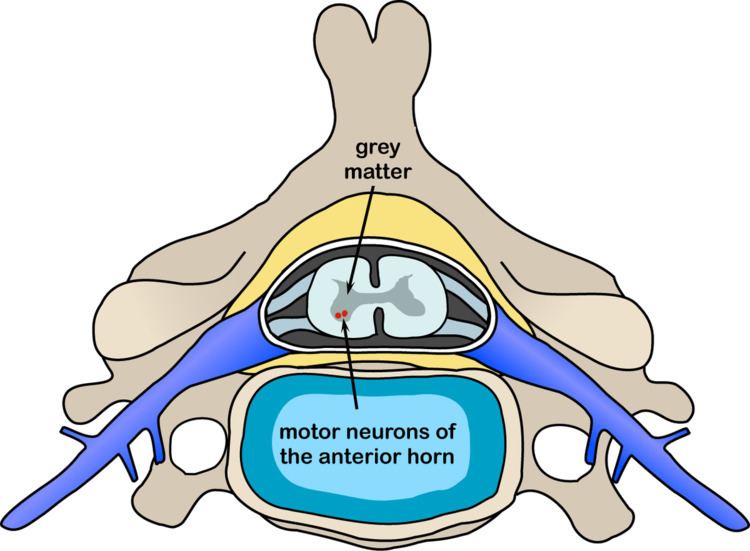Specialty neurology MeSH D009134 | ICD-10 G12 | |
 | ||
Spinal muscular atrophies (SMAs) are a genetically and clinically heterogeneous group of rare debilitating disorders characterised by the degeneration of lower motor neurons (neuronal cells situated in the anterior horn of the spinal cord) and subsequent atrophy (wasting) of various muscle groups in the body. While some SMAs lead to early infant death, other types permit normal adult life with only mild weakness.
Contents
Classification
Based on the type of muscles affected, spinal muscular atrophies can be divided into:
When taking into account prevalence, spinal muscular atrophies are traditionally divided into:
A more detailed classification is based on the gene associated with the condition (where identified) and is presented in table below.
In all forms of SMA (with an exception of X-linked spinal muscular atrophy type 1), only motor neurons, located at the anterior horn of spinal cord, are affected; sensory neurons, which are located at the posterior horn of spinal cord, are not affected. By contrast, hereditary disorders that cause both weakness due to motor denervation along with sensory impairment due to sensory denervation are known as hereditary motor and sensory neuropathies (HMSN).
Symptoms
In all spinal muscular atrophies, the primary feature is muscle weakness accompanied by atrophy of muscle. This is the result of denervation, or loss of the signal to contract that is transmitted by the motor neurons in the spinal cord. The signal is normally transmitted from the spinal cord to muscle via the motor neuron's axon, but in spinal muscular atrophies either the entire motor neuron or the motor neuron's axon loses the ability to transmit signals to muscles.
The symptoms are strongly related to the exact disease (see above) and, sometimes, to the age of onset. Certain conditions (e.g., spinal muscular atrophy or spinal and bulbar muscular atrophy) have a wide range, from infancy to adult, fatal to trivial, with different affected individuals manifesting every shade of impairment between these two extremes. Other muscular atrophies have a different and often very severe course. Some of them are extremely rare and described only in a handful of individuals. However, in all cases the majority of symptoms are a consequence of muscle weakness.
Diagnosis
While the presence of several symptoms may point towards a particular genetic disorder of the spinal muscular atrophy group, the actual disease can be established with full certainty only by genetic testing which detects the underlying genetic mutation.
Treatment
Since December 2016, autosomal recessive proximal spinal muscular atrophy can be treated with nusinersen. No cure is known to any of the remaining disorders of the spinal muscular atrophies group. The main objective there is to improve quality of life which can be measured using specific questionnaires. Supportive therapies are widely employed for patients who often also require comprehensive medical care involving multiple disciplines, including pulmonology, neurology, orthopedic surgery, critical care, and clinical nutrition. Various forms of physiotherapy and occupational therapy are frequently able to slow down the pace of nerve degeneration and muscle wasting. Patients also benefit greatly from the use of assistive technology.
